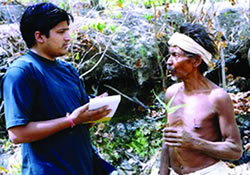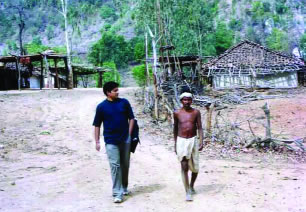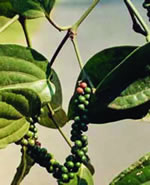Positive Health Online
Your Country

Medicinal Plants for Curing Common Ailments in India
by Dr Deepak Acharya(more info)
listed in herbal medicine, originally published in issue 102 - August 2004
Plants have much relevance to socio-economic, socio-religious aspects of human life in India. Central India is covered with tropical forests, which are supposed to be rich in biodiversity. However, subtropical hill forests are found in few areas. About 500 species of medicinal plants are found. Some of the medicinal plants are on the verge of extinction. Rare flora are also found in the region.
Chhindwara District of Central India (Madhya Pradesh) lies among 21°23' and 22°49' north and longitude 78°10' and 79°24' east. It is situated near the south border of Madhya Pradesh. Tribal peoples are the inhabitants of this district in rural areas. Deep in the heart of Central India there is a wild forest surrounded by sheer 1,200 feet high cliffs. Patalkot is spread over an area of 79 sq.km. at an average height of 2,750-3,250 feet above mean sea level. Doodh river flows in the picturesque valley. It is a treasure of forest and herbal wealth. There are 12 villages and 13 hamlets in this valley, with a total population of 2,012 (1,017 male and 995 female). Most of the people belong to Bharia and Gond tribes.

Dr Acharya documenting traditional information
by a tribal of Patalkot
Because of the inaccessibility of this area, the tribal peoples of this region were totally cut off from the civilized world. But, with the constant efforts of the government, they started tasting the advantages of civilized life. The Patalkot forest is so well hidden that people on the outside didn't even know it existed. It is a very special place, rich with plants and animals. The natives who live there know how to collect and grow the plants they need for food, clothing and building their homes. They also have a special skill that has been passed down to every generation. They know the secrets of the medicine plants. Gonds and Bharias are chief among the tribal population.
There are no proper health facilities in several tribal areas. They still follow the traditional system of medicine. They use plants for curing various ailments. In the present study, the author has surveyed Patalkot and collected information about the medicinal uses of various plants in common disorders.

Dr Acharya documenting traditional information by a tribal of Patalkot
Ethnobotanical work in Patalkot valley has already been done (Rai, 1987, 1987a, 1988, 1989; Rai et al., 1999). But there are still some tribal pockets in Patalkot which could be surveyed in the search for new traditional medicines.
Extensive surveys were carried out from January 2004 to March 2004 in the 20 tribal villages of Patalkot valley. Villagers were interviewed to gather information on medicinal plants. Village chief, local practitioner and Bhumka (local healer) were among the people interviewed.
A Few Common Disorders and Treatments
Coughs and Colds
Tribal peoples in Patalkot use extensive and easy methods to cure this common health disorder. They boil seven Black Peppers fruits (Piper nigrum) in 250 ml water for 20 minutes. They take it directly, go to bed and cover themselves with a bedsheet. This is the commonest way of treating cough. Tribal peoples of Chimtipur have a modified way of treating this disorder. They pick 7-11 leaves from the Basil plant (Ocimum sanctum), 2gm Ginger (Gingiber officinalis) and seven Black Pepper fruits (Piper nigrum). They mix all these in 250 ml boiling water. After filtering, they add 100ml boiled milk and 10gm sugar. This extract is taken twice or thrice a day. Tribal peoples in Chhindi village use Ajwain seeds (Carum copticum). 10gm crushed seeds are tied in a cotton cloth and smelled frequently.

Piper nigrum, a medicinal plant
A few tribal people prepare Vasaca (Adhatoda vasica) extract and give it to a child suffering from cough and cold. Tulsi leaves (Ocimum sanctum) extract is given in mild cough. Mustard oil (Brassica compestris) is applied externally over the lower surface of the foot and a few drops are dropped in the nostrils for relieving a cold.
Tribal peoples of Jaitpur use another way to treat this ailment. They add 3gm crushed Black Pepper and 20gm old Jaggery in 50gm curd. This mixture is taken four times a day to cure a cough and cold.
Fever
6gm each of Amla (Emblica officinalis), Chitrak (Plumbago zeylanica) and Ghost Tree fruit (Ficus religiosa) are added to 40ml of water. This mix is boiled for 25 minutes and taken after filtering it. This extract is said to be very effective if taken thrice a day. Sometimes, tribal people prepare a powder of this material and take it directly. This is good in all types of fever.
Harra (Terminalia chebula), Kutki (Picrorhiza kurroa), Amaltas (Cassia fistula) and Amla (Emblica officinalis) in equal amount are crushed in a mortar and boiled in water. 5ml Honey is also added. This medicine for curing fever is used by the Gonds of Harra Ka Char. Unripe Mango Juice (Mangifera indica) is given in the fever of sunstroke. Tribal peoples in Bijouri prepare extract of Jungli Harra (Terminalia chebula), Clove (Syzygium aromaticum), Bark of Neem (Azadirachta indica), Ginger (Gingiber officinalis), Nagarmotha (Cyprus rotundus) and Giloy (Tinospora cordifolia) 20gm each. They take this extract thrice a day and say it is a wonderful medicine for curing various types of fever.
Tribal peoples of this region sometimes fast for a day or two. Sago (Manihot esculenta), milk and light food are given to the patients suffering from fever.
Dysentery
Tribal peoples in Patalkot treat dysentery by giving salty water to the patient. They prepare a powder of dried Cumin seed (Cuminum cyminum), Mango Seed (Mangifera indica), Aniseed (Foeniculum vulgare) and Ginger (Gingiber officinalis). This powder is given four times a day. This cures dysentery. In severe cases, it is taken six times a day. Some tribal peoples apply Ginger extract (Gingiber officinalis) near the navel. Aniseed (Foeniculum vulgare) 12gm and 6gm Cumin seed (Cuminum cyminum) taken with water is good in dysentery. Powder of dried Amla (Emblica officinalis) and Harra (Terminalia chebula) is good for this disorder.
In Gaildubba, tribal peoples prepare extract of Giloy (Tinospora cordifolia), Dry Amla (Emblica officinalis), Nagarmotha (Cyprus rotundus), Bel (Aegle marmelos) and Coriander leaves (Coriandrum sativum) 10gm each. They give this extract to the patient suffering from severe dysentery.
Worms
This is a common disorder among tribal children. Tribal peoples have various applications of medicinal/ common plants to cure this ailment. They take two big Tomatoes (Lycopersicum esculantum) and mix them with crushed Black Pepper (Piper nigrum). They give this mixture to worm affected children. This is a good medicine. No food is given to the child for the next two hours. Worms are killed and the children become healthy.
Ajwain seeds (Carum copticum) mixed in Jaggery are given in worms in Rated. Ajwain seeds (Carum copticum) 0.5gm and a little black salt make a good medicine for this disorder. 10gm extract of Moringa fruit (Moringa oliefera) and honey are good in children. Tribal peoples in Loutia give Mulberry fruits (Morus alba) mixed with the coat of Pomegranate (Punica granatum) fruit to worm affected children. It cures quickly.
Headache
Reetha bark (Sapindus emarginatus) is washed in boiling water which is then dropped in the nostrils to cure headache. Some tribal peoples apply fresh Mint leaves (Mentha arvense) to the head. Roots of Madar (Calotropis procera) are smelled by a few tribal peoples. They say it relieves the pain. Kaner leaves (Thevetia nerifolia) dried and mixed with Coconut Oil are applied to the head for relieving pain. Gwar leaves (Aloe vera) 50gm are mixed with Wheat powder (Triticum aestivum); small balls are prepared and kept in a pot for 2-3 days. The balls are taken once a day to relieve the pain. Lemon leaves (Citrus aurentum) crushed with salt are applied externally. According to Bhumka, Madar leaf extract (Calotropis procera) is dropped into the nostrils to cure this ailment.
Arand roots (Ricinus communis) and Black Pepper (Piper nigrum) are crushed and filtered. It is applied to the head to cure headache.
Dandruff
Tribal peoples of Patalkot apply Lemon juice (Citrus aurantum) and Coconut Oil (Cucus nucifera) to the scalp. They wash their hair with Reetha fruits (Sapindus emarginatus) twice a day in dandruff. Reetha fruits (Sapindus emarginatus) are dipped in water overnight and this water is used in the morning as a shampoo. A few tribal peoples use Coconut Oil (Cocus nucifera) 100gm and Kapur 4gm for curing dandruff. Sometimes they add the juice of two or three Lemons (Citrus aurantum) in a bucket full of water and wash their hair in it. This is an effective way to cure dandruff. Paste of dry Amla powder (Emblica officinalis) is prepared and applied to the head. It gives strength to the hair roots.
Eczema or Fungal Infections
Tribal peoples cure eczema in a traditional way. 100ml of Mustard oil (Brassica compestris) is added to an iron pot. It is boiled and 50gm Neem leaves (Azadirachta indica) are added. Oil is filtered into a bottle. A little Kapur is added. This is an effective treatment. Sometimes they take Neem leaves orally. Marigold leaves (Tagetes erecta) and Titi leaves (Cassia tora) are taken in an equal amount and crushed. This infusion is applied over the affected part. Palash seed (Butea monosperma) oil is good in eczema. Tribal peoples massage with Palash oil often to avoid eczema.
Mouth Ulcer
Harra (Terminalia chebula) chewed after dinner cures mouth ulcer. Basil leaves (Ocimum sanctum) and Tomato juice (Lycopersicum esculentum) are taken for mouth ulcers. Powder of Nirgund (Vitex negundo) and Musli (Chlorophytum borivilicum) is prepared and taken four times a day for mouth ulcers. Mulberry (Morus alba) juice is given to infants for this ailment. Tribal peoples in Kareyam prepare extract of Jamun leaves and apply this to the affected part. It also removes foul taste in the mouth. Akarkara (Spilanthes calva) flower is chewed in mouth ulcers. It gives strength to the teeth. Ash of burnt fruit bark of the Water Melon is also given.
Result and Discussion
Research and follow-up work are the keys to integrating folk medicine into modern primary health care. The major objective should be to match safe, effective remedies to common illnesses, using local medicinal plants. The problem is that very little is known about folk medicines, and it is impossible to say how effective they are without a lot more research.
This survey provides some evidence that the Gond and Bharia tribes of Patalkot valley use plants in various ailments. The tribal people depend totally on herbal medicines as there is no clinic in the village. The medicinal plants of this region are generally used in stomach disorders, skin diseases, as aphrodisiacs, in fever, as tonics, in ulcers, asthma, snake-bite, respiratory diseases, leucorrhoea, dandruff, eye-diseases and diabetes. There is need for training on conservation and cultivation of medicinal plants. There is also a greater need to develop a garden of medicinal plants of the area. Tribal people can also be encouraged to take up this job as an income generation activity.
Over-exploitation of plants like safed musli, chironji, sarpagandha and bach has made them endangered species. Some plants like Sieges beckia are also found in this valley. My aim is to spread knowledge about plants and their ethnomedicinal importance. I am trying my best to put information on the uses and conservation of medicinal plants of Patalkot valley, but, so far, as in so many places, the biodiversity of Patalkot is threatened. I am currently documenting the medicinal plants found here. It is the need of the hour to prepare a plan for conservation of medicinal plants as well as for the documentation of the knowledge of local tribes.
Acknowledgement
The author is grateful to Dr S A Brown, Principal, Danielson College, Chhindwara and Prof M K Rai, Head, Department of Biotechnology, Amaravati University, Maharastra for constant support. I am thankful to Dr Sanjay Pawar for his critical suggestions.
References
Rai MK. Ethnomedicinal Studies of Patalkot and Tamiya (Chhindwara) – Plants used as tonic. Ancient Science of Life. 3(2): 119-121. 1987.
Rai MK. Ethnomedicinal Studies of Chhindwara District (M.P.). I. Plants used in stomach disorders. Indian Medicine. 1(2): 1-5. 1989.
Rai MK, Acharya D, Nordenstam B. The family Asteraceae in the Chhindwara District of Madhya Pradesh, India. Compositae Newsletter. 33: 46-58. 1999.
Rai MK. Ethno-medicinal studies of Patalkot and Tamiya (Distt. Chhindwara) M.P. – Plants used as tonic. Ancient Science of Life. 7(2): 119-121. 1987a.
Rai MK. Ethnomedicinal survey of Patalkot and Tamiya (District Chhindwara) – I: Plants used against skin diseases and liver disorders. Journal of Economic and Taxonomic Botany. 12(2): 337-339. 1988.
Rai MK. Ojha GC. Ethnomedicinal studies of Chhindwara District (M.P.) – I. Plants used in stomach disorders. Indian Medicine (Vijayawada). 1(2): 1-5. 1989.
Comments:
-
No Article Comments available